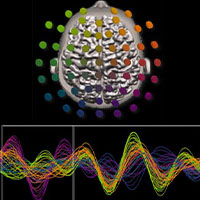
Emmanuelle Tognoli and Scott Kelso were awarded a patent called
The five-dimensional (5D) colorimetric (5D) technique.
The method is designed to interpret large data-sets with
complex Spatio-temporal patterns, such as neuroimaging data.
Florida Atlantic University received a U.S. patent for a new method to display large amounts of data in a color-coded, easy-to-read graph. Neuroscientists Emmanuelle Tognoli, Ph.D., and Scott Kelso, Ph.D., both researchers at the Center for Complex Systems and Brain Sciences at FAU, originally designed the method to interpret enormous amounts of data derived from their research on the human brain. The method, called a five dimensional (5D) colorimetric technique, is able to graph spatiotemporal data (data that includes both space and time), which has not previously been achieved. Until now, spatiotemporal problems were analyzed either from a spatial perspective (for instance, a map of gas prices in July 2013), or from a time-based approach (evolution of gas prices in one county over time), but not simultaneously from both perspectives. Without both space and time, analysts have been faced with an incomplete picture until now, with the creation of the 5D colorimetric technique.
“A considerable number of problems in our society are spatiotemporal ones,” said Tognoli. “With this new tool, we are much better equipped to tackle big data, to see the big picture.”
The new method has already been used to examine climatic records of sea surface temperature at 65,000 points around the world over a period of 28 years and provided scientists with a clear understanding of when and where temperature fluctuations occur. While the possibilities are endless, a few practical examples of use for the 5D colorimetric technique could include tracking gas prices per county, analyzing foreclosure rates in different states or tracking epidemiological data for a virus.
Tognoli and Kelso’s research involves tracking neural activity from different areas of the human brain every one thousandth of a second. This creates a massive amount of data that is not easy to understand using conventional methods.
“Using the 5D colorimetric technique, these huge datasets are transformed into a series of color-coded dynamic patterns that actually reveal the neural choreography completely,” said Kelso. Combining this new method with conceptual and theoretical tools in real experiments will help us and others elucidate the basic coordination dynamics of the human brain.”
“In solving a problem facing their own research, Drs. Kelso and Tognoli have provided an answer for many other scientists trying to analyze large amounts of data,” said Dennis J. Crudele, interim university president. “I can see this method being adopted by scientists and analysts to help in diagnosing, remediating and improving some of society’s most pressing issues.
Coverage around the web: